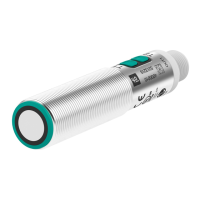UC***-18GS series
Description of Sensor Parameters
2020-11
57
8.4.8 Temperature Compensation
The speed of sound and subsequently an ultrasonic sensor's accuracy is affected by changes
in ambient temperature. By using the "Temperature compensation" parameter, you can switch
the sensor's integral automatic temperature compensation off and on.
When this parameter is enabled, the distance value is calculated taking into account the ambi-
ent temperature continuously measured by the sensor. This method automatically corrects
measuring errors resulting from a changing ambient temperature and thus greatly improves the
measurement accuracy of the sensor.
If disabled, the distance value is calculated on the basis of the temperature value provided by
the "operating temperature" parameter.
Temperature Compensation in Practice
With active temperature compensation, ambient temperature is measured within the sensor
housing. The accuracy of this temperature measurement can be falsely influenced by external
influences which heat or cool the sensor housing. Such influences can be, for example:
• Solar radiation
• High load on the sensor output resulting in a great deal of heat within the sensor housing
• Cleaning the sensor with cold water
In applications with significant fluctuations in ambient temperature, e.g., as a result of heat pro-
duced by machines and/or processing, or outside, we generally recommend enabling tempera-
ture compensation
In applications with an almost constant temperature, e.g., in large tanks, it may be useful to dis-
able automatic temperature compensation. This is useful because then other influences (see
note) will not impact measurement accuracy.
Note
This parameter is visible in the DTM advanced view.
Parameter name Access Value range
Temperature compensation Read/write • Inactive
• Active (factory setting)
• Active with power-on-drift
compensation
Table 8.26
Note
The power-on-drift compensation can further improve the accuracy of data in those initial
minutes after switching on the sensor. A correction factor is calculated based on the self-
heating of the sensor measured after switch-on. This factor results in stable measurement
results as early as two minutes post-commissioning. For temperature compensation without
power-on-drift compensation, this stability is typically only the case after ten minutes.
Note
Internal temperature compensation can be disabled if the ambient temperature of the ultrasonic
sensor is measured on the process side. The measured value of the ultrasonic sensor can then
be corrected in the downstream logic unit taking into account the measured ambient
temperature.

